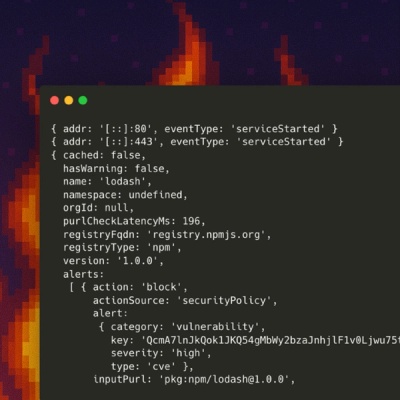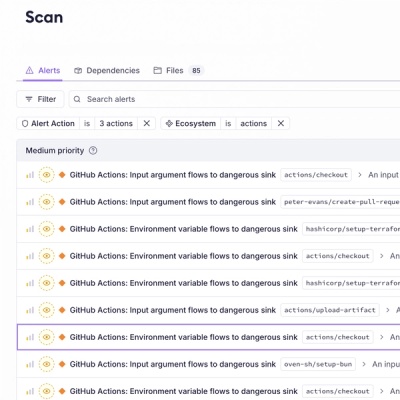
Product
Introducing Socket Firewall Enterprise: Flexible, Configurable Protection for Modern Package Ecosystems
Socket Firewall Enterprise is now available with flexible deployment, configurable policies, and expanded language support.
Don't repeat yourself, JSON: Add support for (circular) references, class instances, ...
JSON-dry allows you to stringify objects containing circular references, dates, regexes, ...
It can also be used to serialize and revive instances of your own classes.
$ npm install json-dry
This is a basic example of stringifying an object (containing multiple references to the same object) and parsing it again.
var Dry = require('json-dry');
// The object we'll serialize later
var obj = {};
// The object we'll make multiple references to
var ref = {
date : new Date(),
regex : /test/i
};
// Now we'll make multiple references:
// `reference_one` and `reference_two` both point to the same object
// `date` refers to a `Date` object
obj.reference_one = ref;
obj.reference_two = ref;
obj.date = ref.date;
// Stringify the object
var dried = Dry.stringify(obj);
// {
// "reference_one": {
// "date": {
// "dry": "date",
// "value": "2018-01-14T17:45:57.989Z"
// },
// "regex": {
// "dry": "regexp",
// "value": "/test/i"
// }
// },
// "reference_two": "~reference_one",
// "date": "~reference_one~date"
// }
// Now we'll revive it again
var undried = Dry.parse(dried);
// { reference_one: { date: 2018-01-14T17:56:43.149Z, regex: /test/i },
// reference_two: { date: 2018-01-14T17:56:43.149Z, regex: /test/i },
// date: 2018-01-14T17:58:50.427Z }
// See if they're the same objects (as it should)
undried.reference_one == undried.reference_two;
// true
// The date outside of the reference object is also the same reference
undried.reference_one.date == undried.date;
// true
Let's create an example class you might want to serialize and revive:
// The class constructor
function Person(options) {
this.firstname = options.firstname;
this.lastname = options.lastname;
}
// A simple method that prints out the full name
Person.prototype.fullname = function fullname() {
return this.firstname + ' ' + this.lastname;
};
// Create an object
var jelle = new Person({firstname: 'Jelle', lastname: 'De Loecker'});
// Test out the fullname method
jelle.fullname();
// returns "Jelle De Loecker"
So now we've created a very basic class, let's register the class and add the 2 required methods for serializing & reviving.
// We need to register the class
Dry.registerClass(Person);
// Add the `toDry` method that will be called upon when serializing/stringifying
Person.prototype.toDry = function toDry() {
return {
value: {
firstname : this.firstname,
lastname : this.lastname
}
};
};
// Now add the `unDry` method as a **static** method, on the constructor
Person.unDry = function unDry(value) {
// How you do this is up to you.
// You can call the constructor for this simple class,
// or you can use Object.create, ...
var result = new Person(value);
return result;
};
Now let's try stringifying it:
var dried = Dry.stringify(jelle);
// {"value":{"firstname":"Jelle","lastname":"De Loecker"},"dry_class":"Person","dry":"toDry","drypath":[]}
// And parse it again
var undried = Dry.parse(dried);
// Person { firstname: 'Jelle', lastname: 'De Loecker' }
// And it works
undried.fullname();
// returns "Jelle De Loecker"
While Dry.stringify will return you with a json-valid string, Dry.toObject will give you a valid simplified object.
In fact: Dry.stringify is just a function that performs JON.stringify on Dry.toObject's output.
Why would you want to use this? Things like Workers and IndexedDB communicate data using the structured clone algorithm. So instead of performing expensive stringify operations you can just use these objects.
JSON-Dry offers a specialized clone method. While in theory you could clone an object by drying end reviving it, like so:
var cloned = Dry.parse(Dry.toObject(jelle))
This is 14x slower than using clone, because toObject needs to generate paths, escape certain string values and create wrapper objects. These expensive things can be ignored when cloning:
var cloned = Dry.clone(jelle);
If you've added a toDry and unDry method to your class, by default the clone method will use those to create the clone.
However, you can also create another method that gets precedence:
Person.prototype.dryClone = function dryClone(seen_map, custom_method) {
return new Person({
firstname : this.firstname,
lastname : this.lastname
});
}
The clone method takes an extra parameter called custom_method. If you're cloning something that has a function property with the same name, that'll be used.
This can be used when you want to redact certain parts, for example:
Person.prototype.specialOccasionClone = function specialOccasionClone(seen_map, custom_method) {
return new Person({
firstname : this.firstname[0] + '.', // Only add the first letter of the name
lastname : this.lastname
});
};
var special_clone = Dry.clone(jelle, 'specialOccasionClone');
special_clone.fullname();
// Returns "J. De Loecker"
1.0.0 (2018-01-15)
protoblast packageWeakMap is now used instead of multiple Array objectsclone method has been addedFAQs
Don't repeat yourself, JSON: Add support for (circular) references, class instances, ...
We found that json-dry demonstrated a not healthy version release cadence and project activity because the last version was released a year ago. It has 1 open source maintainer collaborating on the project.
Did you know?

Socket for GitHub automatically highlights issues in each pull request and monitors the health of all your open source dependencies. Discover the contents of your packages and block harmful activity before you install or update your dependencies.

Product
Socket Firewall Enterprise is now available with flexible deployment, configurable policies, and expanded language support.

Security News
Open source dashboard CNAPulse tracks CVE Numbering Authorities’ publishing activity, highlighting trends and transparency across the CVE ecosystem.

Product
Detect malware, unsafe data flows, and license issues in GitHub Actions with Socket’s new workflow scanning support.